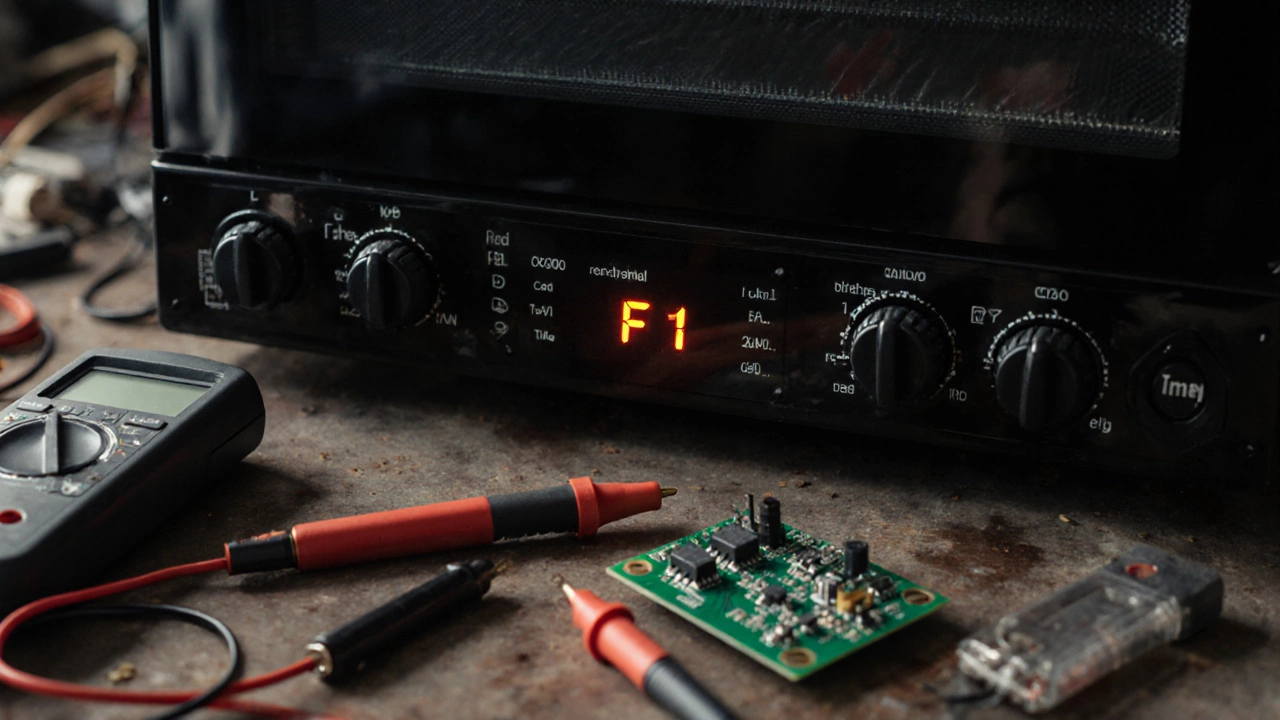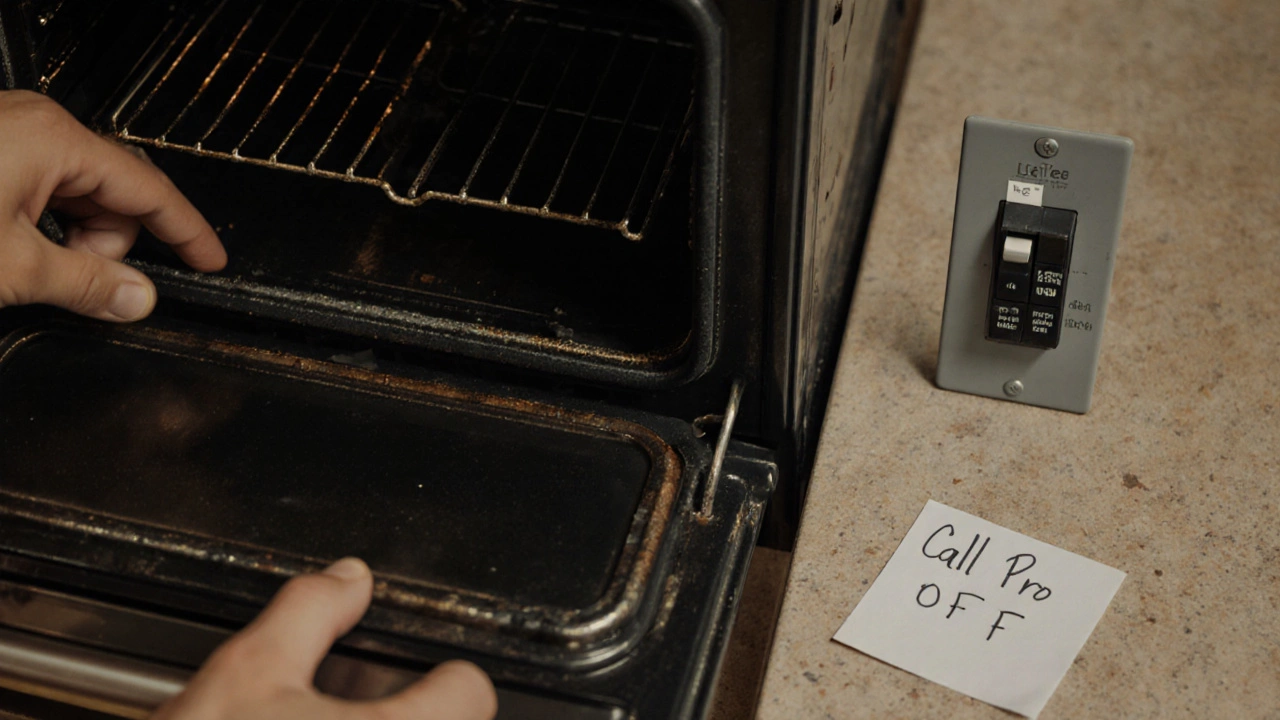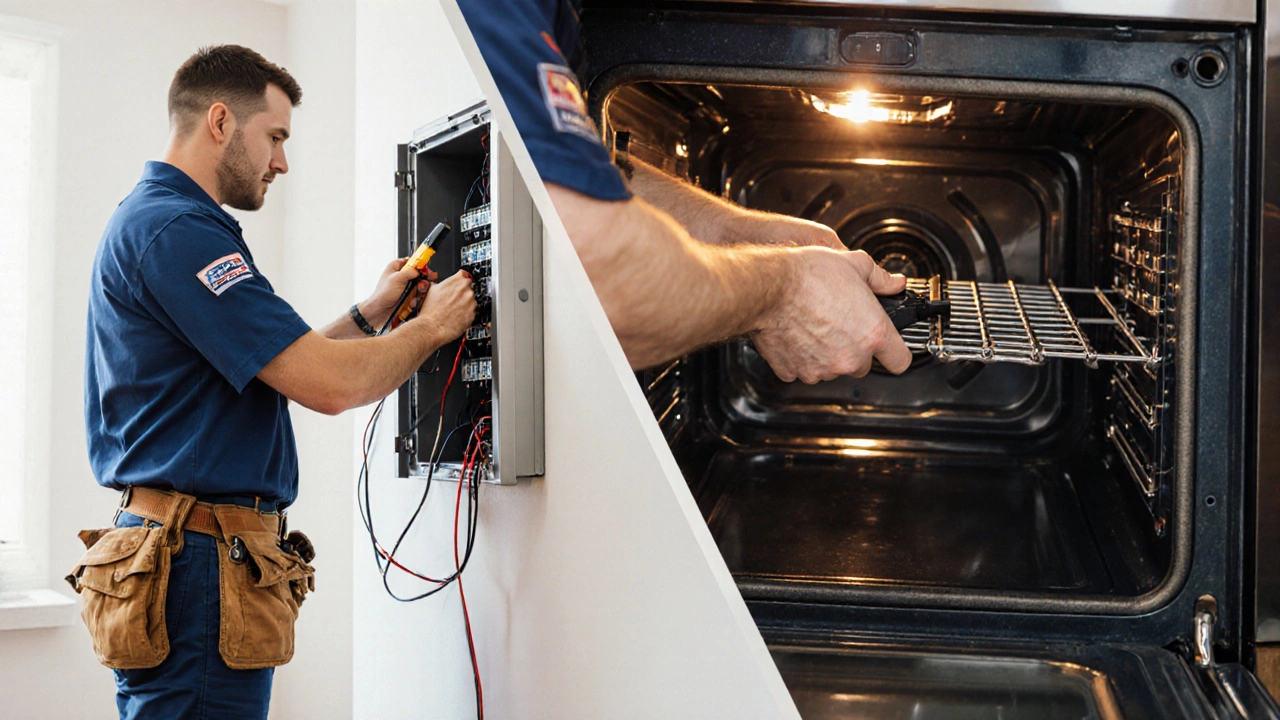If your electric oven won’t heat up, the display is dead, or it keeps tripping the circuit breaker, you might be tempted to call an electrician. But should you? The short answer: sometimes. But not always. And knowing the difference can save you time, money, and a lot of frustration.
Electric ovens need both electrical and mechanical skills
An electric oven isn’t just a box plugged into the wall. It’s a system. You’ve got heating elements, thermostats, control boards, door switches, fans, and wiring-all working together. When something breaks, it could be a simple fuse, a burnt-out element, or a faulty control panel. But it could also be a problem with the 240-volt circuit feeding it.An electrician knows how to test voltage, trace wiring, and fix issues with your home’s electrical system. A qualified appliance technician knows how to test a bake element with a multimeter, replace a thermal fuse, or reset a control board. The best outcome? You get someone who can do both.
Most electricians aren’t trained to diagnose a faulty oven control board. Most appliance techs aren’t licensed to work on your main electrical panel. That’s where confusion sets in.
When to call an electrician
You should call an electrician if:- Your oven trips the circuit breaker every time you turn it on
- The oven won’t power on at all, and other appliances on the same circuit are fine
- You smell burning wires or see scorch marks near the outlet or junction box
- The oven is wired directly into your home’s panel (not a plug-in model) and there’s no power at the terminal block
- You’ve had recent electrical work done, and the oven stopped working afterward
These are signs the problem is with your home’s wiring, the circuit breaker, the dedicated 240-volt line, or the outlet. Electricians are the only ones legally allowed to open your main panel or rewire circuits. If the issue is electrical supply, an appliance technician can’t fix it.
When to call an appliance technician
Call a certified appliance repair technician if:- The oven turns on but doesn’t heat
- The display shows error codes like F1, E3, or H1
- One heating element works but the other doesn’t
- The fan runs but the oven doesn’t reach temperature
- The door won’t lock (on self-cleaning models)
These are classic signs of internal component failure. A bake element can burn out after 5-10 years. Thermal fuses blow if the oven overheats. Control boards fail from moisture or power surges. These are all things appliance techs replace daily.
In Wellington, where older homes often have outdated wiring, it’s common for electric ovens to have both electrical and appliance issues. But 80% of oven failures are internal-not electrical.
What happens during a repair visit
If you call an appliance technician, they’ll bring a full toolkit: multimeter, continuity tester, replacement elements, fuses, and control boards. They’ll start by checking the power at the oven’s terminal block. If there’s no voltage, they’ll tell you to call an electrician. If there is voltage, they’ll test each component.Here’s what they check:
- Power supply at the terminal block (240V between L1 and L2)
- Bake and broil elements for continuity (open circuit = bad)
- Thermal fuse near the oven cavity (blown if oven overheated)
- Thermostat or temperature sensor (resistance should be around 1000-1100 ohms at room temp)
- Control board (error codes, no display, unresponsive buttons)
- Door latch switch (prevents operation if door isn’t fully closed)
Most repairs take under an hour. Parts cost between $30 and $150. A new bake element? Around $50. A control board? $120-$200. Labor? $80-$120/hour.

Why DIY is risky
You might be tempted to open the oven and swap out parts yourself. But here’s the catch: electric ovens run on 240 volts-twice the voltage of a standard outlet. One mistake, one slip, and you could fry your entire appliance or start a fire.Even if you’re handy, you won’t have the right tools. A basic multimeter won’t tell you if a control board is failing under load. A blown thermal fuse might look fine visually. You need to test it electrically.
Also, many modern ovens have proprietary software. Replacing a control board without resetting it using the manufacturer’s diagnostic mode can leave you with a $200 part and a still-broken oven.
What to do before calling anyone
Before you pick up the phone, do this:- Check your circuit breaker. Reset it if it’s tripped.
- Test other appliances on the same circuit. If they’re dead too, it’s likely a wiring issue.
- Look for error codes on the display. Write them down. They’re the first clue techs need.
- Unplug the oven (if plug-in) or turn off the breaker for 5 minutes. Then restore power. Sometimes this resets a glitch.
- Make sure the oven isn’t in a delayed start or lock mode.
If the oven still doesn’t work after that, don’t guess. Call a professional.
How to find the right pro
If you think it’s an electrical issue, find a licensed electrician with experience in appliance circuits. Ask: “Have you worked on 240-volt oven circuits before?”If you think it’s an appliance issue, look for a technician certified by the manufacturer or a recognized trade body like the Appliance Repair Association. Ask if they carry parts for your brand-Samsung, Bosch, Fisher & Paykel, or Electrolux.
In Wellington, many repair companies offer both services. They’ll send an appliance tech first. If they find an electrical problem, they’ll bring in an electrician on the same day. That’s the ideal scenario.

When to replace instead of repair
If your oven is over 12 years old, and the repair cost is more than half the price of a new one, consider replacing it. New models are 20-30% more energy efficient. Many now have Wi-Fi diagnostics, self-cleaning modes, and better temperature control.Also, if you’ve had multiple repairs in the last two years, it’s probably time. Ovens don’t get better with age. They just get more expensive to fix.
Look for models with a 5-year parts warranty. Fisher & Paykel and Bosch are popular in New Zealand for reliability. Avoid no-name brands sold at discount stores-they often use cheaper components that fail faster.
Common myths about electric oven repair
- Myth: All oven problems are electrical. Truth: Only 15-20% are. Most are failed heating elements or control boards.
- Myth: Electricians can fix any oven. Truth: They can fix the power, but not the bake element.
- Myth: If the light works, the oven is getting power. Truth: The light runs on 120V. The heating elements need 240V. One can work without the other.
- Myth: You can replace a control board yourself. Truth: Without the right diagnostic software, you’ll likely brick it.
Understanding these myths saves you from wasted time and money.
Final advice
Don’t assume an electrician is the answer. Don’t assume an appliance tech can fix your wiring. The right call depends on the symptom.Start with the simplest fix: check the breaker. Then look for error codes. If you’re unsure, call an appliance repair company that works with electricians. Most offer free diagnostics. They’ll tell you exactly what’s wrong-and who needs to fix it.
Electric ovens are built to last. But like any machine, they need the right expert at the right time. Get that right, and your oven will serve you for another decade.
Can any electrician repair an electric oven?
No. Only electricians who specialize in appliance circuits can handle the wiring side. Most general electricians don’t know how to test oven elements, control boards, or thermostats. You need someone who understands both electrical systems and appliance components.
Is it cheaper to repair or replace an electric oven?
If the oven is under 8 years old and the repair costs less than half the price of a new one, repair is usually cheaper. For older ovens, especially those needing a control board ($150+) or multiple parts, replacement is often more cost-effective. New energy-efficient models can cut your electricity bill by 20-30%.
Why won’t my electric oven turn on at all?
Common causes include a blown thermal fuse, a failed control board, a tripped circuit breaker, or no power at the terminal block. First, check your breaker. If that’s fine, the issue is likely internal. An appliance technician can test the fuse and board. If there’s no voltage at the terminal block, you’ll need an electrician.
Can a faulty outlet cause my oven to stop working?
Yes, but only if it’s a plug-in oven. Most electric ovens are hardwired directly into a 240-volt circuit. If your oven is hardwired and not working, the problem is likely the circuit, junction box, or internal components-not the outlet. A faulty outlet would only matter if the oven plugs in.
How long does an electric oven repair usually take?
Most repairs take 30 to 90 minutes. Replacing a bake element or thermal fuse can be done in under an hour. Control board replacements or complex diagnostics may take longer, especially if parts need to be ordered. Many technicians carry common parts in their vans.

I am an expert in the services industry with a focus on appliance repair. My passion lies in understanding how things work and educating others in simple, engaging ways. This enthusiasm fuels my writing, where I delve into topics around appliance maintenance and troubleshooting. I aim to make these subjects clear and accessible to all readers.